Statistics
2020 Health Manpower Survey
Summary of the Characteristics of Chinese Medicine Practitioners Enumerated
I. Chinese Medicine Practitioners Covered
1.1 The following three types of Chinese medicine practitioners, with exclusion of those subsequently found to have passed away on or before the survey reference date of 31 August 2020, were covered in the 2020 Health Manpower Survey on Chinese medicine practitioners (HMS - CMP):
| (i) | Registered Chinese Medicine Practitioners |
| who were registered with the Chinese Medicine Council of Hong Kong under section 69 of the Chinese Medicine Ordinance (Chapter 549) as at the survey reference date of 31 August 2020. | |
| (ii) | Chinese Medicine Practitioners with Limited Registration |
| who were registered with the Chinese Medicine Council of Hong Kong under section 85 of the Chinese Medicine Ordinance (Chapter 549) as at the survey reference date of 31 August 2020. | |
| (iii) | Listed Chinese Medicine Practitioners |
| whose names had been entered on the list of listed Chinese medicine practitioners maintained by the Chinese Medicine Council of Hong Kong under section 90 of the Chinese Medicine Ordinance (Chapter 549) as at the survey reference date of 31 August 2020. |
1.2 The number of Chinese medicine practitioners covered was 9 925, which included 7 485 (75.4%) registered Chinese medicine practitioners, 31 (0.3%) Chinese medicine practitioners with limited registration and 2 409 (24.3%) listed Chinese medicine practitioners.
II. Response Rate
2.1 Of the 9 925 Chinese medicine practitioners covered, 1 785 responded to the HMS - CMP, giving an overall response rate of 18.0%. The response rate of registered Chinese medicine practitioners was 19.9%, while that of Chinese medicine practitioners with limited registration and listed Chinese medicine practitioners were 35.5% and 11.7% respectively.
III. Activity Status
3.1 The responding Chinese medicine practitioners were classified as either “economically active”* or “economically inactive”*. Economically active (“active”) Chinese medicine practitioners included:
(a)“employed” Chinese medicine practitioners - Chinese medicine practitioners practising in the Chinese medicine profession in Hong Kong during the survey period; and
(b)“unemployed” Chinese medicine practitioners - Chinese medicine practitioners who (i) were not practising in the local Chinese medicine profession during the survey period; (ii) had been available for work during the seven days before the survey† AND (iii) had sought work in the local Chinese medicine profession during the 30 days before the survey‡.
3.2 Economically inactive (“inactive”) Chinese medicine practitioners referred to the responding Chinese medicine practitioners who were not practising in the Chinese medicine profession in Hong Kong during the survey period, excluding those who were on leave during the survey period and who were “economically active” but “unemployed”.
IV. Registered Chinese Medicine Practitioners
4.1 Among the 1 491 responding registered Chinese medicine practitioners, 1 366 (91.6%) were “active” and 125 (8.4%) were “inactive” in the local Chinese medicine profession as at 31 August 2020 (Chart A).
4.2 Of the 1 366 active registered Chinese medicine practitioners enumerated, 1 298 (95.0%) were practising in the local Chinese medicine profession, 28 (2.0%) were seeking jobs and 14 (1.0%) reported that they had not been available for work because of temporary sickness. Among the 1 366 respondents, 26 (1.9%) reported that they were available for work but had not sought work during the 30 days before the enumeration due to reasons including: expecting to return to their original jobs; waiting to take up a new job; starting business at subsequent date; or believed that work was not available in the local Chinese medicine profession. The survey results presented in paragraph 4.4 to 4.13 were based on the 1 298 responding registered Chinese medicine practitioners who were practising in the local Chinese medicine profession as at 31 August 2020. The percentages presented below may not add up to 100% due to missing responses or rounding (Chart A).
4.3 Of the 125 inactive registered Chinese medicine practitioners enumerated, 113 (90.4%) reported not seeking jobs in the local Chinese medicine profession during the 30 days before enumeration, eight (6.4%) reported practising in the Mainland and four (3.2%) did not indicate the reason for being inactive. Among the 113 inactive registered Chinese medicine practitioners who reported not seeking jobs in the local Chinese medicine profession, the main reasons included: 45 (39.8%) were working in other professions, 36 (31.9%) were retired, 16 (14.2%) wanted to take a rest / had no motive to work / had no financial need and 11 (9.7%) were engaged in household duties, etc (Chart A).
| Note: | * | In the survey, the criteria used in defining economically active / inactive followed those recommended by the International Labour Organization, which are also being used by the Census and Statistics Department in Hong Kong. |
| † | The respondent would be classified as “unemployed” if he/ she had sought work but had not been available for work because of temporary sickness. | |
| ‡ | he respondent would also be classified as “unemployed” if he/ she fulfilled conditions (i) and (ii) but had not sought work during the 30 days before enumeration because he/ she believed that work was not available; or had made arrangements to take up a new job; or start business on a subsequent date; or was expecting to return to the original job in the local Chinese medicine profession. |
Chart A : Activity Status of Registered Chinese Medicine Practitioners Covered
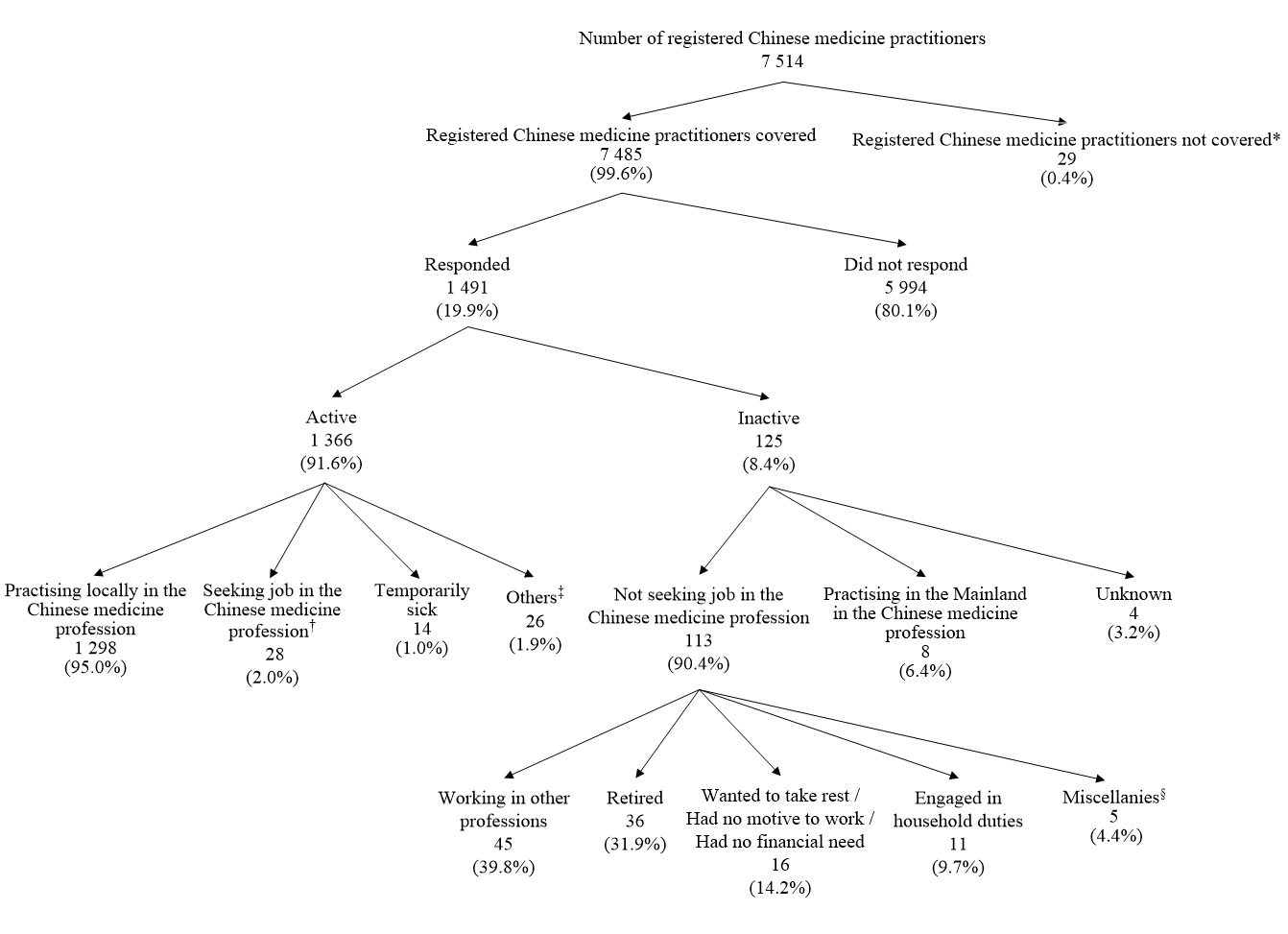
| Note: | * | Figure refers to the number of registered Chinese medicine practitioners subsequently found to have passed away on or before 31.8.2020. |
| † | Figure refers to the number of responding registered Chinese medicine practitioners who (a) were not practising in the Chinese medicine profession in Hong Kong during the survey period; (b) had been available for work during the seven days before the survey; AND (c) had sought work in the Chinese medicine profession during the 30 days before the survey. | |
| ‡ | Figure refers to the number of responding registered Chinese medicine practitioners who (a) were not practising in the Chinese medicine profession in Hong Kong during the survey period; (b) had been available for work during the seven days before the survey; AND (c) had not sought work during the 30 days before enumeration because he/ she believed that work was not available; or had made arrangements to take up a new job; or start business on a subsequent date; or was expecting to return to the original job in the local Chinese medicine profession. | |
| § | Figure refers to the number of responding registered Chinese medicine practitioners who reported undertaking study, emigrated, etc. | |
| Percentages may not add up to 100% due to rounding. |
4.4 After excluding the one active registered Chinese medicine practitioner practising in the local Chinese medicine profession enumerated who did not indicate the gender, among the remaining 1 297 active registered Chinese medicine practitioners enumerated who were practising in the local Chinese medicine profession, there were 806 (62.1%) male and 491 (37.9%) female, giving an overall sex ratio (males per 100 females) of 164. Excluding 12 respondents who did not indicate their age, the median age of the remaining 1 286 active registered Chinese medicine practitioners practising in the local Chinese medicine profession enumerated was 60.0 years (median age of female was 53.0 years and median age of male was 63.0 years).
4.5 The responding active registered Chinese medicine practitioners practising in the local Chinese medicine profession were requested to indicate the characteristics of their main jobs*. Among the 1 298 respondents, 1 131 (87.1%) of them reported as working in the private sector, 83 (6.4%) in the subvented sector, 42 (3.2%) in the academic sector, 30 (2.3%) in the Hospital Authority and four (0.3%) in the Government.
4.6 For the active registered Chinese medicine practitioners practising in the local Chinese medicine profession enumerated, the median age for those working in the private sector was 61.0 years, compared to 40.5 years for those working in the academic sector, the subvented sector (36.0 years), the Government (32.5 years) and the Hospital Authority (30.0 years).
4.7 Of the 1 298 active registered Chinese medicine practitioners practising in the local Chinese medicine profession enumerated, 80.4% spent most of their working time on clinical general practice, while 10.8% reported spending most of their working time on clinical bone-setting and 6.4% reported clinical acupuncture as the main area of work.
4.8 The median number of hours of work per week (excluding meal breaks) of the 1 298 active registered Chinese medicine practitioners practising in the local Chinese medicine profession enumerated was 40.0 hours, amongst which 170 (13.1%) were required to undertake on-call duty (excluding normal duty), with a median of 12.0 hours of on-call duty (excluding normal duty) per week.
4.9 Among the 1 298 respondents, 60.5% had passed the Licensing Examination (Section 61(1)(a) of the Chinese Medicine Ordinance). The remaining included listed Chinese medicine practitioners who had been exempted from the Licensing Examination (Section 93 of the Chinese Medicine Ordinance) (18.5%), those who had passed the Licensing Examination (Section 95 of the Chinese Medicine Ordinance) (12.3%) and those who had passed the Registration Assessment (Section 94 of the Chinese Medicine Ordinance) (8.6%) as the earlist basic qualification.
4.10 Of the 1 298 active registered Chinese medicine practitioners practising in the local Chinese medicine profession enumerated, 777 (59.9%) had received / were receiving additional training after they became Chinese medicine practitioners, amongst which 285 (36.7%) held Master’s Degree, 187 (24.1%) held Certificate, 101 (13.0%) held Bachelor’s Degree, 99 (12.7%) held Doctoral Degree, 66 (8.5%) held Diploma as the highest qualification and 37 (4.8%) had not yet completed the additional training.
4.11 Of the 777 respondents who had received / were receiving additional training after they became Chinese medicine practitioners, 379 (48.8%) had received / were receiving training in one field only, which included training in acupuncture and moxibustion of Chinese medicine (31.1%), internal medicine of Chinese medicine (15.8%), orthopaedics and traumatology of Chinese medicine (12.7%), gynaecology of Chinese medicine (6.3%), Hong Kong healthcare system and regulatory system of Chinese medicine (4.5%) and training programme related to the Chinese medicine pracitioners licensing examination (4.5%) (Chart B).
| * | Main jobs referred to the jobs in which the registered Chinese medicine practitioners had spent most of their working time. |
Chart B: Number of Field(s) of Additional Training Received / Being Received by Active Registered Chinese Medicine Practitioners Enumerated
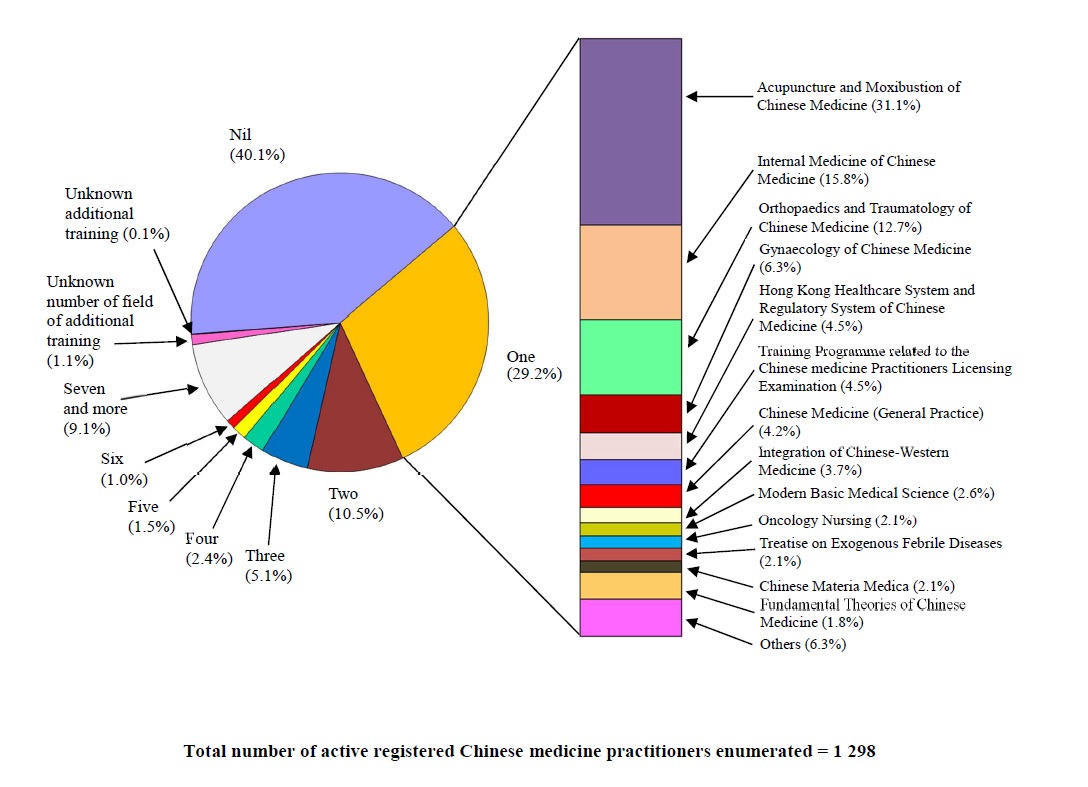
4.12 Of the 777 active registered Chinese medicine practitioners practising in the local Chinese medicine profession who had received / were receiving additional training after they became Chinese medicine practitioners, 384 (49.4%) indicated more than one field of additional training. The more commonly reported fields included: acupuncture and moxibustion of Chinese medicine which was reported by 251 (65.4%) of the 384 respondents, internal medicine of Chinese medicine which was reported by 236 (61.5%) of the respondents, orthopaedics and traumatology of Chinese medicine which was reported by 186 (48.4%) of the respondents, gynaecology of Chinese medicine which was reported by 181 (47.1%) of the respondents and fundamental theories of Chinese medicine which was reported by 140 (36.5%) of the 384 respondents.
4.13 Regarding Continuing Education in Chinese Medicine (CME) activities, 1 204 (92.8%) of the active registered Chinese medicine practitioners practising in the local Chinese medicine profession reported that they had participated in CME activities in 2020, 84 (6.5%) reported no participation in any CME activities and ten (0.8%) did not report whether they had participated in CME activities or not. Among the 1 204 respondents who had participated in CME activities, the distribution of CME points attained in the past 12 months was: 1 to 10 points (15.7%), 11 to 20 points (20.0%), 21 to 30 points (19.4%), 31 to 40 points (11.4%) and more than 40 points (33.6%).
V. Chinese Medicine Practitioners with Limited Registration
5.1 Under section 83 of the Chinese Medicine Ordinance, where an educational or scientific research institution intends to engage a limited registered Chinese medicine practitioner, to perform predominantly clinical teaching or research in Chinese medicine for the institution, the institution may apply to the Chinese Medicine Practitioners Board on behalf of the person for limited registration of that person. Thus, all the 11 responding Chinese medicine practitioners with limited registration were “economically active” in the local Chinese medicine profession as at 31 August 2020 (Chart C).
Chart C: Activity Status of Chinese Medicine Practitioners with Limited Registration Covered
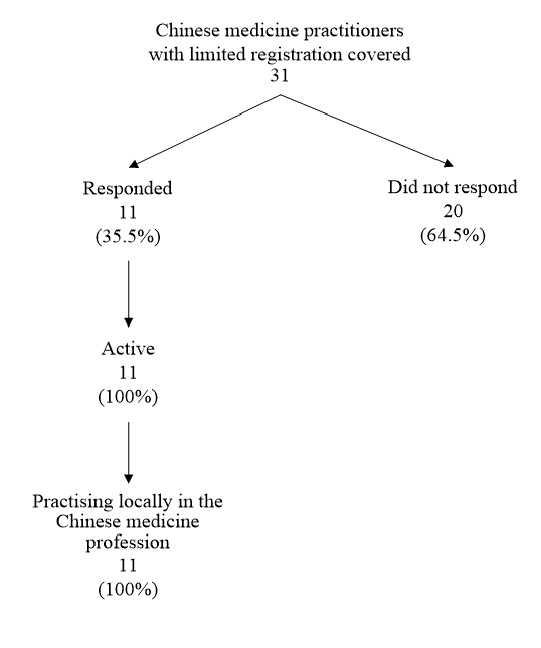
5.2 Of the 11 active Chinese medicine practitioners with limited registration enumerated, nine (81.8%) were male and two (18.2%) were female, giving an overall sex ratio (males per 100 females) of 450. The median age of the 11 active Chinese medicine practitioners with limited registration enumerated was 58.0 years. The median age of the active female Chinese medicine practitioners with limited registration enumerated was 60.0 years and that of their male counterparts was 58.0 years.
5.3 The responding active Chinese medicine practitioners with limited registration practising in the local Chinese medicine profession were requested to indicate the characteristics of their main jobs*. The 11 respondents all reported as working in the academic sector.
5.4 Of the 11 active Chinese medicine practitioners with limited registration practising in the local Chinese medicine profession enumerated, 90.9% reported spending most of their working time on teaching and 9.1% reported clinical general practice.
5.5 The median number of hours of work (excluding meal breaks) per week of the 11 respondents was 40.0 hours. One (9.1%) of the respondents was required to undertake on-call duty (excluding normal duty).
5.6 Of the 11 active Chinese medicine practitioners with limited registration practising in the local Chinese medicine profession enumerated, four (36.4%) had received / were receiving additional training after they became Chinese medicine practitioners, with the highest qualification attained being Certificate (one), Master’s Degree (one) and Doctoral Degree (one). The remaining one respondent had not yet completed the additional training.
5.7 Three of the respondents (75.0%) had received / were receiving training in one field only; and the fields of additional training were reported as Psychology (one), acupuncture and moxibustion of Chinese medicine (one) and integration of Chinese-Western medicine respectively (one).
| * | Main jobs referred to the jobs in which the Chinese medicine practitioners with limited registration had spent most of their working time. |
VI. Listed Chinese Medicine Practitioners
6.1 Among the 283 listed Chinese medicine practitioners who had responded to the survey, 230 (81.3%) were active and 53 (18.7%) were inactive in the local Chinese medicine profession as at 31 August 2020 (Chart D).
6.2 Of the 53 inactive listed Chinese medicine practitioners enumerated, four (7.5%) reported practising in the Mainland and 49 (92.5%) reported not seeking job in the local Chinese medicine profession during the 30 days before the survey, amongst which 30 (61.2%) reported as retired, 15 (30.6%) reported as working in other professions and four (8.2%) reported reasons such as undertaking study, wanted to take rest / had no motive to work / had no financial need and were engaged in household duties (Chart D).
6.2 1.1 Of the 230 active listed Chinese medicine practitioners enumerated, 221 (96.1%) were practising in the local Chinese medicine profession. The remaining nine respondents who were not practising in the local Chinese medicine profession included six (2.6%) who reported as having temporary sickness and three (1.3%) who were seeking jobs in the local Chinese medicine profession during the 30 days before the survey. The survey results presented from paragraph 6.4 to 6.10 were based on the 221 responding listed Chinese medicine practitioners practising in the local Chinese medicine profession as at 31 August 2020. The percentages presented below may not add up to 100% due to missing responses or rounding (Chart D).
Chart D: Activity Status of Listed Chinese Medicine Practitioners Covered
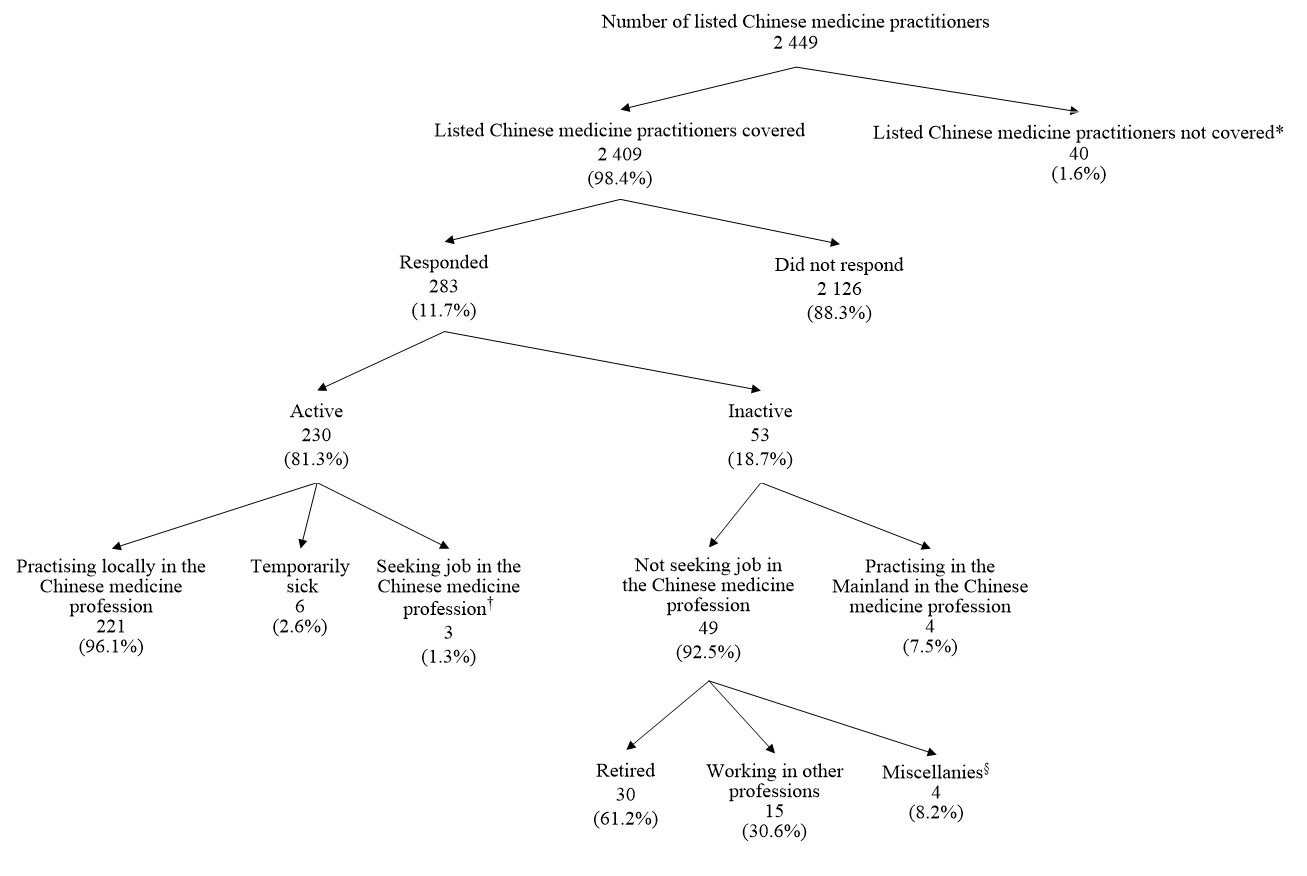
| Note: | * | Figure refers to the number of listed Chinese medicine practitioners subsequently found to have passed away on or before 31.8.2020. |
| † | Figure refers to the number of responding listed Chinese medicine practitioners who (a) were not practising in the Chinese medicine profession in Hong Kong during the survey period; (b) had been available for work during the seven days before the survey; AND (c) had sought work in the Chinese medicine profession during the 30 days before the survey. | |
| ‡ | Figure refers to the number of responding listed Chinese medicine practitioners who were undertaking study, wanted to take rest / had no motive to work / had no financial need and were engaged in household duties. | |
| Percentages may not add up to 100% due to rounding. |
6.4 The 221 active listed Chinese medicine practitioners practising in the local Chinese medicine profession enumerated included 175 (79.2%) males and 46 (20.8%) females, giving an overall sex ratio (males per 100 females) of 380. The median age was 67.0 years (female median age was 66.0 years; male median age was 67.0 years).
6.5 The responding active listed Chinese medicine practitioners were requested to indicate the characteristics of their main jobs*. The majority (216 out of 221 respondents, 97.7%) of the active listed Chinese medicine practitioners practising in the local Chinese medicine profession enumerated were working in the private sector.
6.6 Of the 221 active listed Chinese medicine practitioners practising in the local Chinese medicine profession enumerated, 56.1% spent most of their working time on clinical general practice, followed by 28.1% on clinical bone-setting and 12.2% on clinical acupuncture.
6.7 The median number of hours of work (excluding meal breaks) per week of the 221 respondents was 30.0 hours. Among the 221 respondents, 29 (13.1%) were required to undertake on-call duty (excluding normal duty), with a median of 15.0 hours of on-call duty (excluding normal duty) per week.
6.8 Of the 221 active listed Chinese medicine practitioners practising in the local Chinese medicine profession enumerated, 99 (44.8%) had received / were receiving additional training after they became listed Chinese medicine practitioners, amongst which 59 (59.6%) held Certificate, 21 (21.2%) held Diploma, seven (7.1%) held Bachelor’s Degree as the highest qualification. Six (6.1%) had not yet completed the additional training.
6.9 Of the 99 respondents who had received / were receiving additional training after they became listed Chinese medicine practitioners, 44 (44.4%) had received / were receiving training in one field only, which included orthopaedics and traumatology of Chinese medicine (29.5%), training programme related to the Chinese medicine practitioners licensing examination (25.0%), acupuncture and moxibustion of Chinese medicine (13.6%) and Chinese medicine (general practice) (9.1%) (Chart E).
6.10 Of the 99 respondents who had received / were receiving additional training after they became listed Chinese medicine practitioners, 55 (55.6%) indicated more than one field of additional training. The more commonly reported fields included: diagnostics of Chinese medicine (reported by 76.4%, 42 of the 55 respondents), internal medicine of Chinese medicine (reported by 69.1%, 38 of the 55), medical prescriptions in Chinese medicine (reported by 67.3%, 37 of the 55), fundamental theories of Chinese medicine (reported by 65.5%, 36 of the 55) and Chinese materia medica (reported by 63.6%, 35 of the 55).
| * | Main jobs referred to the job in which the listed Chinese medicine practitioners had spent most of their working time. |
Chart E : Number of Field(s) of Additional Training Received / Being Received by Active Listed Chinese Medicine Practitioners Practising in the Local Chinese Medicine Profession Enumerated
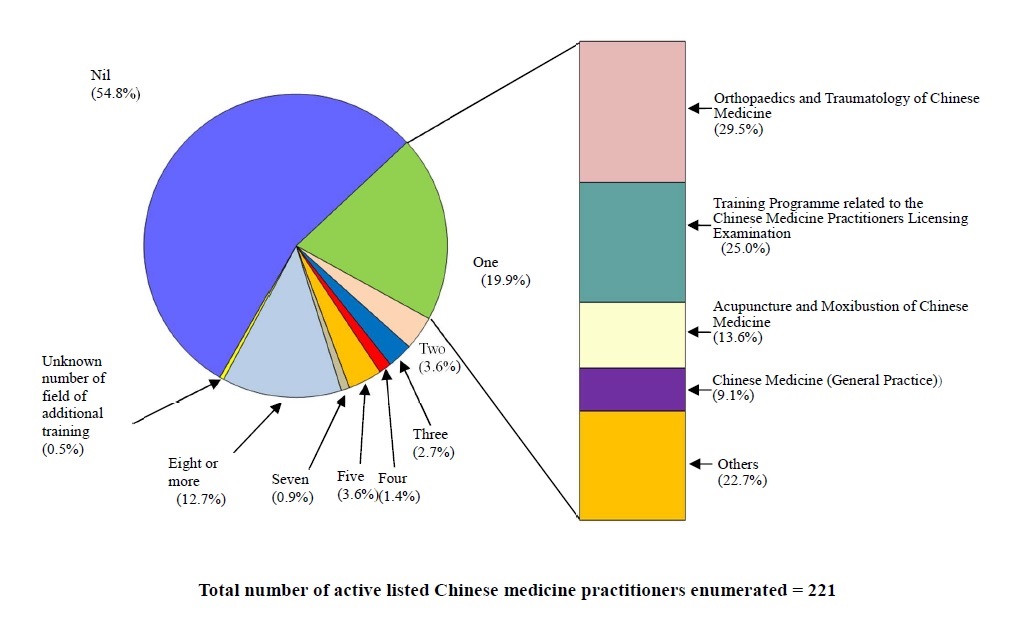
VII. Trend Analysis
7.1 The number of registered Chinese medicine practitioners covered increased from 6 726 in 2014 to 7 485 in 2020. The number of Chinese medicine practitioners with limited registration covered decreased from 63 in 2014 to 31 in 2020 while the number of listed Chinese medicine practitioners covered decreased from 2 702 in 2014 to 2 409 in 2020 (Chart F).
Chart F : Number of Chinese Medicine Practitioners Covered by Year (2014, 2017 and 2020)
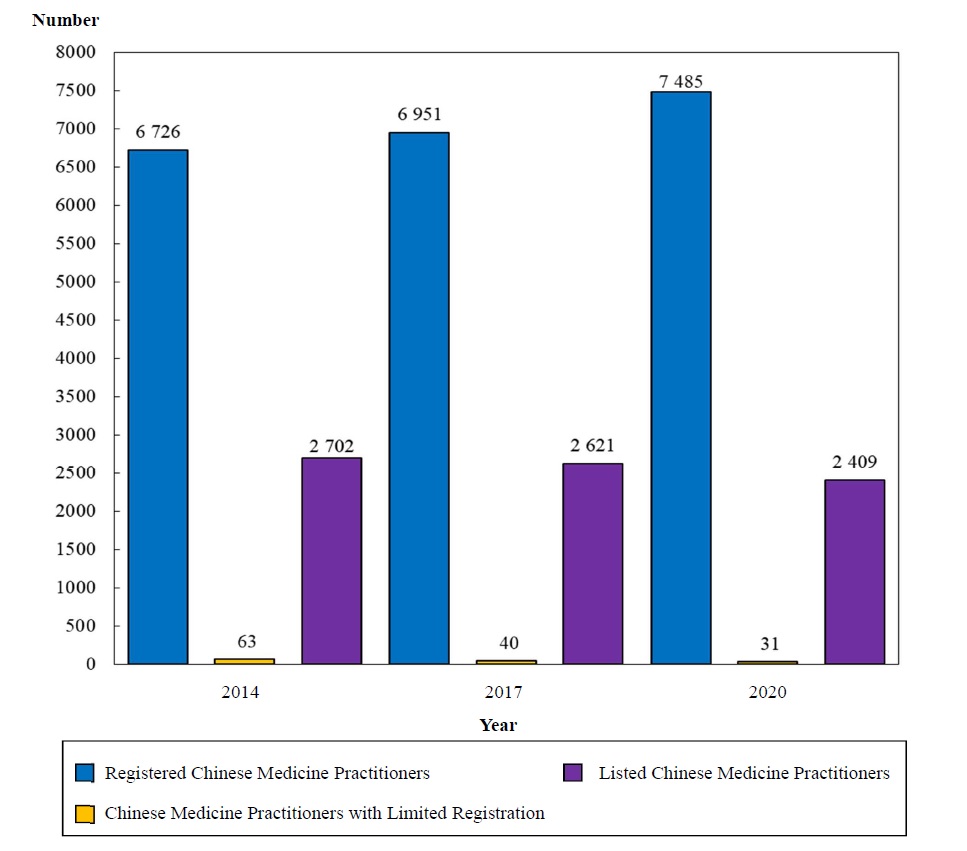
| Note: | Figures refer to Chinese medicine practitioners registered with the Chinese Medicine Council of Hong Kong or entered on the list of listed Chinese medicine practitioners maintained by the Chinese Medicine Council of Hong Kong under section 90 of the Chinese Medicine Ordinance (Chapter 549) as at 31 August of the respective years. Figure of 2020 also excluded those who were subsequently found to have passed away on or before the survey reference date of 31 August 2020. |
7.2 The median age of the active registered Chinese medicine practitioners practising in the local Chinese medicine profession enumerated in 2020 was 60.0 years, compared to 58.0 years in 2014 and 2017. The median age of the active listed Chinese medicine practitioners practising in the local Chinese medicine profession enumerated in 2020 was 67.0 years, compared to 65.0 years in 2017 and 62.0 years in 2014. On the other hand, the median age of the active Chinese medicine practitioners with limited registration practising in the local Chinese medicine profession enumerated in 2020 was 58.0 years, compared to 63.0 years in 2017 and 62.0 years in 2014 (Table A).
7.3 The sex ratio of active registered Chinese medicine practitioners practising in the local Chinese medicine profession enumerated in 2020 was 164 (males per 100 females), compared to 159 in 2017 and 196 in 2014. From 2014 to 2020, the sex ratio (males per 100 females) of active Chinese medicine practitioners with limited registration practising in the local Chinese medicine profession enumerated varied between 250 to 533, while the sex ratio (males per 100 females) of active listed Chinese medicine practitioners practising in the local Chinese medicine profession enumerated varied between 319 to 421 (Table A).
7.4 A large proportion (over 85%) of the active registered Chinese medicine practitioners practising in the local Chinese medicine profession enumerated in 2020 reported as working in the private sector, similar to the situation reported in surveys of 2017 and 2014 with 85.0% and 86.7% respectively, reported as working in the private sector. For the active listed Chinese medicine practitioners practising in the local Chinese medicine profession enumerated in 2020, more than 95% of respondents reported as working in the private sector, similar to the situation reported in the 2017 and 2014 surveys, with 97.3% and 98.5% respectively, reported as working in the private sector. For the active Chinese medicine practitioners with limited registration practising in the local Chinese medicine profession enumerated in 2020, all (100%) reported as working in the academic sector, compared to the figures of 57.1% in 2014 and 100.0% in 2017 (Table A).
Table A : Selected Characteristics of Active Chinese Medicine Practitioners Practising in the Local Chinese Medicine Profession Enumerated (2014, 2017 and 2020)
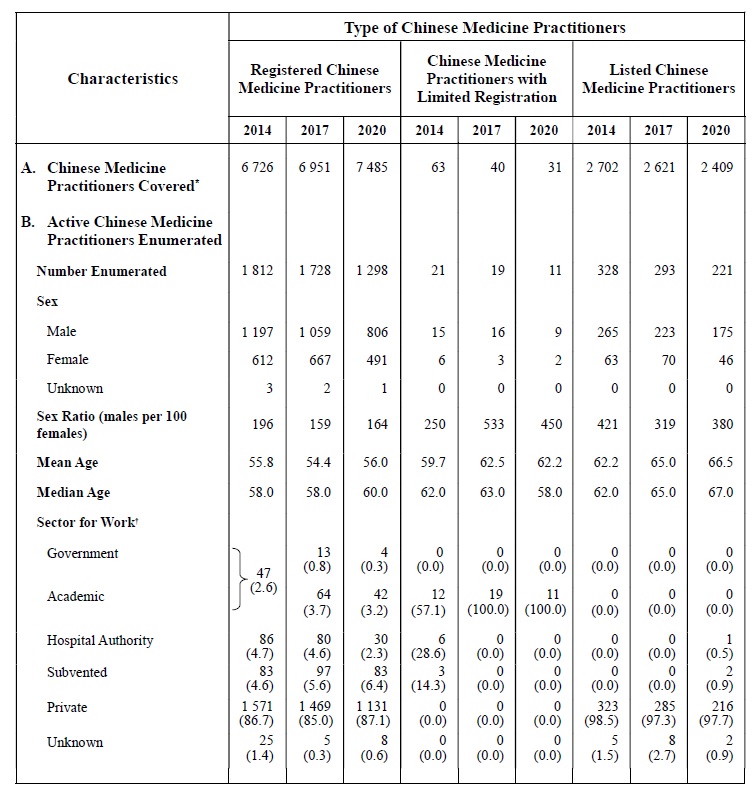
| Note: | * | Figures refer to Chinese medicine practitioners registered with the Chinese Medicine Council of Hong Kong or entered on the list of listed Chinese medicine practitioners maintained by the Chinese Medicine Council of Hong Kong under the Chinese Medicine Ordinance (Chapter 549) as at 31st August of the respective years. Figure of 2020 also excluded those who were subsequently found to have passed away on or before the survey reference date of 31st August 2020. |
| † | Figures of the number of active Chinese Medicine Practitioners working in the Government and academic sector were combined from 2011 to 2014. The figures were reported separately since 2017. | |
| There may be slight discrepancy between the sum of individual items and the total due to rounding. |
VIII. Trend Analysis
8.1 The survey findings only represented the situation as at the survey reference date of 31 August 2020. Analysis on the characteristics of Chinese medicine practitioners performed was based on the data collected on those enumerated Chinese medicine practitioners only. As the characteristics of the non-responding Chinese medicine practitioners may be different from those who responded, the findings may not fully reflect the characteristics of all Chinese medicine practitioners practising in Hong Kong.
8.2 Since the number of Chinese medicine practitioners involved in some of the results was small, readers should interpret the relevant statistics with caution. Since the number of Chinese medicine practitioners involved in some of the results was small, readers should interpret the relevant statistics with caution.